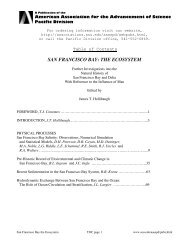Vol 31, Part I - forums.sou.edu ⢠Index page - Southern Oregon ...
Vol 31, Part I - forums.sou.edu ⢠Index page - Southern Oregon ...
Vol 31, Part I - forums.sou.edu ⢠Index page - Southern Oregon ...
Create successful ePaper yourself
Turn your PDF publications into a flip-book with our unique Google optimized e-Paper software.
ABSTRACTS – Contributed Oral Papers<br />
ECOLOGY, ORGANISMAL BIOLOGY,<br />
and ENVIRONMENTAL SCIENCES<br />
Monday, starting at 9:00 a.m. in WILLOWS 2<br />
114a Flowering Patterns following Tephra Disturbance of<br />
Understory Herbs in Old-growth Subalpine Forest, DON-<br />
ALD ZOBEL 1 and JOSEPH ANTOS 2 ( 1 Botany and Plant<br />
Pathology, <strong>Oregon</strong> State University, Cordley Hall 2082, Corvallis<br />
OR 973<strong>31</strong>; 2 Biology, University of Victoria, PO Box<br />
3020 STN CSC, Victoria, BC, Canada V8W 3N5; zobeld@<br />
science.oregonstate.<strong>edu</strong>).<br />
During succession, flowering allows plants to increase<br />
in density and to spread farther than via vegetative reproduction.<br />
Within a community, species range from those for<br />
which frequent flowering is essential for spread to those that<br />
rarely flower. However, few studies consider the full variation<br />
in flowering within a community. Here we analyze flowering<br />
of understory herbs, using permanent plots in forests<br />
affected by 1980 tephra from Mount St. Helens. Incidence of<br />
flowering in 1980-83, 2000, 2005, and 2010 was related to<br />
environment and species properties using logistic regression.<br />
Flowering varied widely among species, with some<br />
never flowering. Overall, incidence of flowering was greater<br />
in herb-rich sites than in sites with few species, but there was<br />
no overall difference between sites with 4.5 versus 15 cm<br />
tephra. Plants with a graminoid or a deciduous, non-clonal<br />
growth form had the highest incidence of flowering; clonal<br />
deciduous and clonal evergreen plants were intermediate;<br />
non-clonal evergreen plants seldom flowered. Species limited<br />
to forest flowered more consistently than those that also<br />
grow in meadows or in early seral conditions. With time,<br />
incidence of flowering increased for deep tephra, herb-poor<br />
sites, species that also grow in early-seral sites, and those<br />
restricted to forests. Species differed widely in their patterns<br />
of flowering among years and with environment. Incidence<br />
varied among common species from 0% (Xerophyllum<br />
tenax) of the situations in which a species was present to<br />
85% (Tiarella unifoliata). Where flowering occurred, 4 to<br />
19% of shoots flowered.<br />
115 Testing Monophyly and Phylogenetic Relationships of<br />
Smittium (Harpellales) using a Five-Gene Molecular Phylogenetic<br />
Analysis, YAN WANG 1 *, ERIC D TRETTER 1 ,<br />
ERIC M JOHNSON 1 , PRASANNA KANDEL 1 , Robert<br />
W LICHTWARDT 2 , and MERLIN M WHITE 1<br />
( 1 Department of Biological Sciences, Boise State University,<br />
1910 University Drive, Boise, ID 83725; 2 Department<br />
of Ecology & Evolutionary Biology, University of Kansas,<br />
1200 Sunnyside Avenue, Haworth Hall, Lawrence, KS<br />
66045; Yanwang@u.boisestate.<strong>edu</strong>).<br />
Smittium is a ubiquitous group of fungi, best known<br />
as endosymbionts of various Arthropods, thus commonly<br />
referred to as the gut fungi. During the 75 years since the<br />
first species, Smittium arvernense, was described, Smittium<br />
has grown to include 81 species. The symbiotic relationships<br />
within this genus range from commensalism, mutualism,<br />
to parasitism. This genus has also helped to advance<br />
our understanding of the gut fungi, by serving as a “model”<br />
for laboratory studies of the fungal trichomycetes. Many<br />
isolates of Smittium have been used for host feeding, isozyme,<br />
physiological, serological, ultrastructural, and now<br />
ongoing molecular systematic studies. Previous and recent<br />
molecular studies have shown that Smittium is polyphyletic<br />
but with consistent separation of Smittium culisetae, one of<br />
the most common and widespread species, from the remainder<br />
of Smittium species. Here we used morphological (sexual<br />
and asexual spores shape), molecular (18S and 28S rRNA<br />
genes), immunological, and isozyme evidence to suggest a<br />
new genus, Zancudomyces, to accommodate Smittium culisetae.<br />
A multi-gene dataset, consisting of 18S and 28S rRNA<br />
genes, as well as RPB1, RPB2, and MCM7 translated protein<br />
sequences for Smittium and related Harpellales (Austrosmittium,<br />
Coleopteromyces, Furculomyces, Pseudoharpella,<br />
Stachylina and Trichozygospora), was used for phylogenetic<br />
analyses to test the monophyly of Smittium. A consensus<br />
tree was generated with strong support at multiple levels.<br />
The clades and branches of the tree were assessed relative<br />
to morphological traits for the taxa of interest, including<br />
holdfast shape, thallus branching type, trichospore (asexual<br />
spore) and zygospores (sexual spore) characters as an aid to<br />
inform the taxonomy and eventual systematic revisions and<br />
reclassification. A narrower genus definition of Smittium was<br />
supported by molecular data, and approved by morphological<br />
reexamination.<br />
116 Investigating the Presence and Impacts of Wolbachia,<br />
a Bacterial Symbiont, on a Threatened Butterfly, AMY<br />
TRUITT* and CATHERINE De RIVERA (Department<br />
of Environmental Science and Management, Portland State<br />
University, 1825 SW Broadway, Portland, OR 97201; amtruitt@pdx.<strong>edu</strong>).<br />
The endosymbiotic bacteria, Wolbachia, likely affect<br />
population dynamics of the imperiled <strong>Oregon</strong> silverspot butterfly,<br />
(Speyeria zerene hippolyta, OSB) and may have been<br />
a contributor in the decline of its many extirpated populations.<br />
Some strains of Wolbachia induce cytoplasmic incompatibility<br />
between its host insects and uninfected conspecifics,<br />
including for many Lepidoptera. The goals of this study<br />
were to determine: if this species is infected with Wolbachia,<br />
whether infection affects population growth of this butterfly.<br />
We conducted a screen for Wolbachia infection by collecting<br />
samples from archived female butterflies (from 1999<br />
and 2001-2011, n=234), extracting DNA from the samples,<br />
and employing polymerase chain reaction protocols using<br />
Wolbachia-specific primers. Reproduction data, eggs laid<br />
and eggs hatched, for infected versus uninfected individuals<br />
were analyzed. Proportion of infected individuals per year<br />
was compared to population indices.<br />
81








